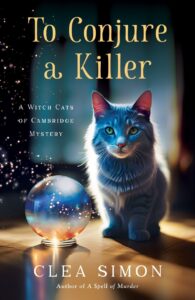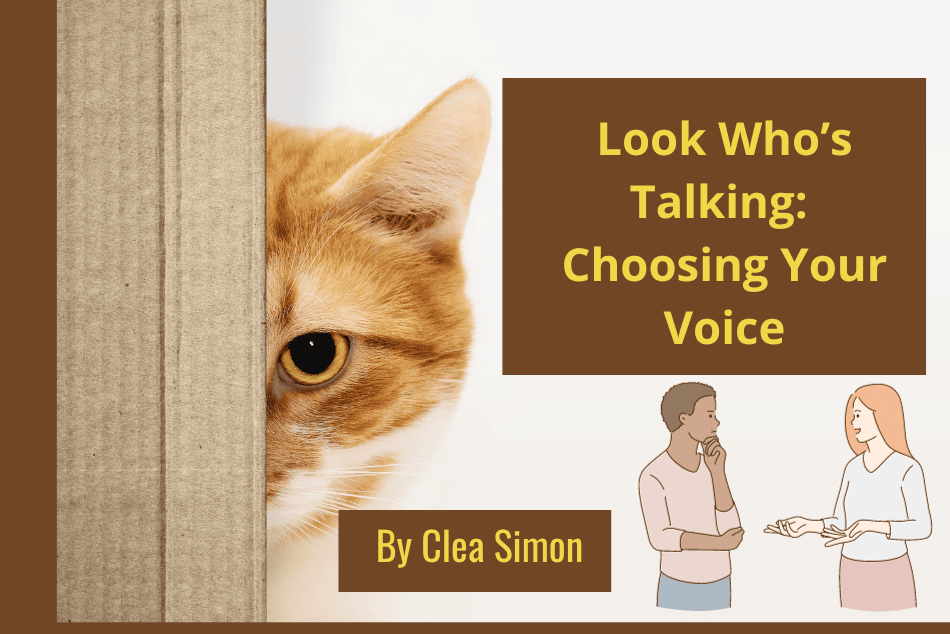When my agent was marketing A Spell of Murder, the first of my “Witch Cats of Cambridge” cozy series, we received an interesting query: Would I consider recasting the book, which is narrated by a cat, so that at least 80% of it was narrated by a human?
The query came from a reputable publisher, and it was at that point as close as we’d come to selling the series. (The series is now with Polis, and the fourth book, To Conjure a Killer, comes out Nov. 14.) My agent at the time urged me to consider it seriously. I did – and that query made me ask myself a vital question: Who was at the center of my story?
We writers talk a lot about voice and point of view (POV). But all of that depends on one question: Who do we want to be telling this story? Who, really, matters?
The answer isn’t always obvious. In my case, Becca Colwin is the apparent center of my “witch cat” mysteries. Not only is she the central human character – which means we human readers should be able to relate to her – she’s also the hapless human who has set herself up as a witch detective, despite her not having any real magical powers. Her struggles, therefore, are at the center of the series books, up to and including To Conjure a Killer.
But that didn’t make her my POV character. That publisher was right: she could have been. It can be exciting to have the main character telling the reader about every clue and twist. But it can also be limiting.
Odds are, especially if you’re writing a mystery, your main character will miss some clues or misinterpret others. It can help, then, to have someone else narrating. And when I started writing my “witch cats” books, I instinctively went in another direction.
It might be useful here to review what we mean by voice. For starters, there’s first-person narration: the “I” narration. “The most amazing thing happened to me,” you tell your friends. This voice has a freshness – the experience happened to the narrator! Plus, it lets you show what your narrator thinks and feels about a situation (“I was so furious, I could’ve killed him. But I didn’t”). However, it also limits the writer. All you can write about is what this character saw or heard or tasted, with no outside perspective.
Second person is the “You” voice. “You saw what happened. You were there.” This voice has an immediacy, but it’s hard to maintain and seldom used. You try writing something entirely in the second person. You’ll see.
Then there’s third person. This is the classic for storytelling. The “once upon a time” option, or in my case, it would have been: “Becca stepped cautiously into the dark alley, unaware that a body lay at its end.” The broadest of these allows a God-like omniscience: your narrator knows everything, which – as you can see – can bring along its own problems. Granted, you the writer can choose what to reveal and what not to, but if your narrator already knows it all, creating suspense can be troublesome.
That’s where third-person limited comes in. In my case, I’ve chosen to make Clara, one of Becca’s three cats, the primary (third-person) narrator: “The vet nodded, his generous mouth set in a line as he turned his attention back to the kitten. Clara couldn’t tell if he had heard the hesitation in Becca’s voice. …”
Now isn’t that more fun than: “Becca hesitated, which the vet didn’t seem to notice”?
Plus, Clara notes so many things as she follows Becca around and tries to keep her out of trouble. (There’s only so much one small cat can do!) She sees much of what Becca sees, albeit from a perspective closer to the ground, and because of her sharp feline senses often gets a little more out of each encounter. But because she’s not omniscient, she doesn’t always piece together the clues she runs across. That leaves something for the reader.
Plus – and this is what I think made me choose her – Clara loves Becca. She worries about her human, as any good cat will, but she also respects her intelligence and generosity. She sees the best in Becca, even as she tries to compensate for her shortcomings. If, along the way, she can make my readers feel some sympathy for my would-be witch detective, I’m content. And if she comments on any stray happenings that Becca has missed – and which might be clues for the reader to lap up – so much the better. That made Clara the heart of my “Witch Cat” books, the one I wanted telling the story.
How did you choose the POV character for your novel? Why did you make that decision? Let’s talk about it on the Career Authors Facebook Page.

 Clea Simon is the author of more than two dozen mysteries, most of which involve cats, and three nonfiction books, including the Boston Globe bestseller, The Feline Mystique: On theMysterious Connection Between Women and Cats. A former journalist and New York native, she now lives in Massachusetts, the setting of TO CONJURE A KILLER, the fourth in her “witch cats of Cambridge” series. She can be found at www.CleaSimon.com and on Instagram (cleasimon_author) and Facebook (Clea Simon).
Clea Simon is the author of more than two dozen mysteries, most of which involve cats, and three nonfiction books, including the Boston Globe bestseller, The Feline Mystique: On theMysterious Connection Between Women and Cats. A former journalist and New York native, she now lives in Massachusetts, the setting of TO CONJURE A KILLER, the fourth in her “witch cats of Cambridge” series. She can be found at www.CleaSimon.com and on Instagram (cleasimon_author) and Facebook (Clea Simon).





